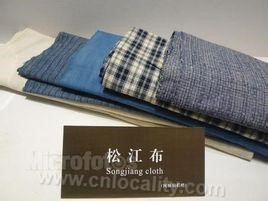welcomeSpecialty Foods Products!

In the early Yuan Dynasty, a woman named Huang Daopo in Wunijing, Songjiang Prefecture (now Songjiang District, Shanghai) returned to her hometown from Hainan Island. Huang Daopo learned a whole set of textile technology from Li sisters in Hainan Island, and after several years, he brought Hainan Island's advanced cotton textile technology back to his hometown. After she returned to Songjiang, she enthusiastically taught the local people how to make textile tools, so that each process had new tools instead of the previous manual work. At the same time, she also taught people how to spin and weave, which made the textile form a relatively perfect and highly efficient production process. Songjiang mansion soon got rid of backward methods and mastered advanced technology, and Songjiang cotton cloth changed from rough, single and loose to exquisite, firm and beautiful. Under the careful teaching of Huang Daopo, Songjiang cloth has become a well-known best-selling product with excellent texture and beautiful flowers. The population engaged in the cotton textile industry has surged, and the emerging cotton textile industry in Songjiang Prefecture has developed rapidly and become an important part of economic development. Due to the constant popularization and promotion, Songjiang cotton textile industry is booming, with higher output and better quality, and Songjiang cotton has gained a good reputation in the country. There are four famous kinds of cotton cloth in Songjiang: three shuttle cloth: it comes from the car pier area in Songjiang, with a width of more than three feet and is characterized by smoothness and fineness. Among them, there is a man named Madame Ting at Shuangmiao Bridge not far from the car pier outside the east gate of Fucheng. He plays cotton very skillfully and flowers fly, which is especially fine and soft for weaving, so he is called "flying flower cloth", also known as "Madame Ting cloth". Fanbu: From Wunijing, taught by Huang Daopo. High quality and high price, "a horse costs as much as a hundred platinum." During Chenghua period of the Ming Dynasty, it was often used as a gift to bribe senior officials of the imperial court and ministers close to the emperor, and the cloth was woven more and more beautifully, and even patterns such as dragons and phoenixes, bullfights and unicorns were woven. Silk cloth: it is woven by mixing hemp or yellow grass with cotton yarn, with hemp as warp and cotton as weft. Suitable for dyeing. The woven cloth has both the crispness of hemp and the softness of cotton yarn. Medicinal patch cloth: also known as "watering cloth", it is what we call blue printed cloth today. Beginning from Qingpu Chonggu area, it became popular in Songjiang City in the Ming Dynasty.
Reprinted with attribution:
https://cnlocality.com/(Chinese Specialty Products)
other
consult:(+86)13225231905